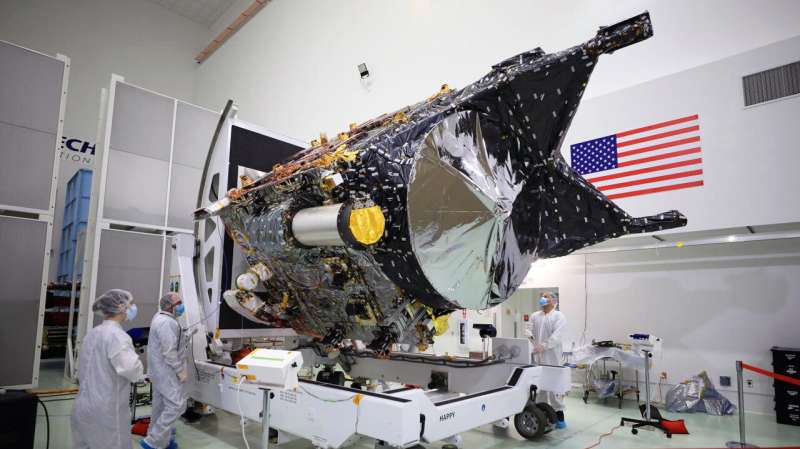This is the farthest-ever demonstration of optical communications.
Riding aboard the recently launched Psyche spacecraft, DSOC is configured to send high-bandwidth test data to Earth during its two-year technology demonstration as Psyche travels to the main asteroid belt between Mars and Jupiter. NASA's Jet Propulsion Laboratory in Southern California manages both DSOC and Psyche.
The tech demo achieved "first light" in the early hours of Nov. 14 after its flight laser transceiver—a cutting-edge instrument aboard Psyche capable of sending and receiving near-infrared signals—locked onto a powerful uplink laser beacon transmitted from the Optical Communications Telescope Laboratory at JPL's Table Mountain Facility near Wrightwood, California.
The uplink beacon helped the transceiver aim its downlink laser back to Palomar (which is 100 miles, or 130 kilometers, south of Table Mountain) while automated systems on the transceiver and ground stations fine-tuned its pointing.
"Achieving first light is one of many critical DSOC milestones in the coming months, paving the way toward higher-data-rate communications capable of sending scientific information, high-definition imagery, and streaming video in support of humanity's next giant leap: sending humans to Mars," said Trudy Kortes, director of Technology Demonstrations at NASA Headquarters in Washington.
Test data also was sent simultaneously via the uplink and downlink lasers, a procedure known as "closing the link" that is a primary objective for the experiment. While the technology demonstration isn't transmitting Psyche mission data, it works closely with the Psyche mission-support team to ensure DSOC operations don't interfere with those of the spacecraft.
"Tuesday morning's test was the first to fully incorporate the ground assets and flight transceiver, requiring the DSOC and Psyche operations teams to work in tandem," said Meera Srinivasan, operations lead for DSOC at JPL. "It was a formidable challenge, and we have a lot more work to do, but for a short time, we were able to transmit, receive, and decode some data."
Before this achievement, the project needed to check the boxes on several other milestones, from removing the protective cover for the flight laser transceiver to powering up the instrument. Meanwhile, the Psyche spacecraft is carrying out its own checkouts, including powering up its propulsion systems and testing instruments that will be used to study the asteroid Psyche when it arrives there in 2028.
First light and first bits
With successful first light, the DSOC team will now work on refining the systems that control the pointing of the downlink laser aboard the transceiver.
Once achieved, the project can begin its demonstration of maintaining high-bandwidth data transmission from the transceiver to Palomar at various distances from Earth. This data takes the form of bits (the smallest units of data a computer can process) encoded in the laser's photons—quantum particles of light.
After a special superconducting high-efficiency detector array detects the photons, new signal-processing techniques are used to extract the data from the single photons that arrive at the Hale Telescope.
The DSOC experiment aims to demonstrate data transmission rates 10 to 100 times greater than the state-of-the-art radio frequency systems used by spacecraft today.
Both radio and near-infrared laser communications utilize electromagnetic waves to transmit data, but near-infrared light packs the data into significantly tighter waves, enabling ground stations to receive more data. This will help future human and robotic exploration missions and support higher-resolution science instruments.
"Optical communication is a boon for scientists and researchers who always want more from their space missions, and will enable human exploration of deep space," said Dr. Jason Mitchell, director of the Advanced Communications and Navigation Technologies Division within NASA's Space Communications and Navigation (SCaN) program. "More data means more discoveries."
While optical communication has been demonstrated in low Earth orbit and out to the moon, DSOC is the first test in deep space. Like using a laser pointer to track a moving dime from a mile away, aiming a laser beam over millions of miles requires extremely precise "pointing."
The demonstration also needs to compensate for the time it takes for light to travel from the spacecraft to Earth over vast distances: At Psyche's farthest distance from our planet, DSOC's near-infrared photons will take about 20 minutes to travel back (they took about 50 seconds to travel from Psyche to Earth during the Nov. 14 test). In that time, both spacecraft and planet will have moved, so the uplink and downlink lasers need to adjust for the change in location.
"Achieving first light is a tremendous achievement. The ground systems successfully detected the deep space laser photons from DSOC's flight transceiver aboard Psyche," said Abi Biswas, project technologist for DSOC at JPL. "And we were also able to send some data, meaning we were able to exchange 'bits of light' from and to deep space."
Provided by NASA



